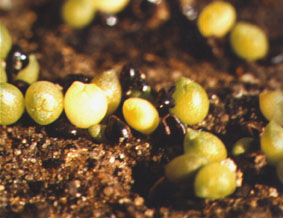FAILURES TO OBTAIN VARIEGATED SPROUTS
N. Shemorakov
 |
| Photo 3.
Seeds of Astrophytum; Melocactus sp ² Holland². |
Trying to discover the most productive method of obtaining variegated forms of cacti, I decided to apply the two types of mutagens: chemicals and radiation. The goal was to understand the effectiveness of each separate mutagen as well as their combination upon the sprouting seeds of different cacti.
As a chemical agent I used water-soluble iron hydroxy acetate salt (CH3COO)2FeOH. I used a 1% solution for watering. As a radiation mutagen I utilized ultra-violet (UV) lamp Q-145 Medicor. The distance between the UV lamp and the seeds did not exceed 4 cm, and exposure time varied from 30 to 90 seconds for different kinds of cacti. The seeds were UV exposed 24 hours after having been sown. Then they were sprayed with distilled water of room temperature, because they had been heated up to 50-60 °C as a result of the UV exposure. After that, all the seeds were kept into a propagator under white fluorescent tubes placed at the height of about 20 cm and set at a 12 hours/day cycle. The temperature in the propagator was not exceeding +29°С at the daytime and was not falling below +19 °С at night.
The full text available in our Printed issue





